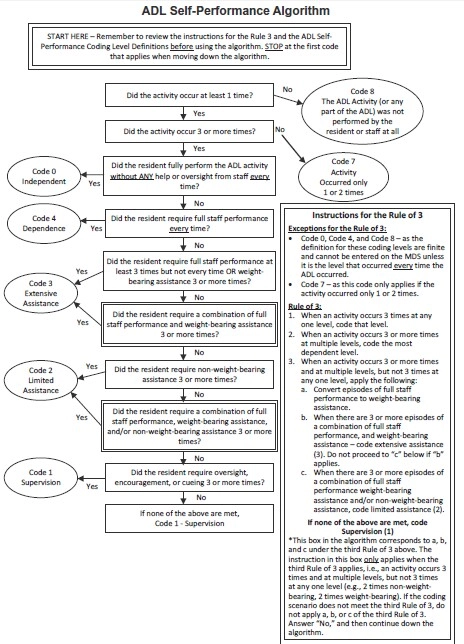If the other MDS sections aren’t looking different enough for you, the Resident Assessment Instrument (RAI) manual has some extensive changes in store when you look at Item G0110 — Activities of Daily Living (ADL) Assistance. And the Centers for Medicare & Medicaid Services (CMS) is yet again tackling the “Rule of 3” beast.
“Over the past several months, CMS has commented in a number of different venues regarding the intended application of the Rule of Three described in the RAI manual,” stated a Sept. 30 Indiana Health Care Association (IHCA) blog posting.
“In these new updates, CMS clarifies the instruction that as the first step to determining the appropriate coding for this section, ‘When an activity occurs three or more times at any one level, code that level,’” IHCA explained.
What’s more: “If this step applies to the situation, providers are instructed not to go on to apply the algorithm,” IHCA said.
What the ‘Rule of 3’ Looks Like Now
In Item G0110’s Coding Instructions, the manual adds a new section, “The Rule of 3.” Included in the revisions is an updated ADL Self-Performance Algorithm as well (see figure on page 114).
“The old ADL algorithm was a major source of misinterpretation,” Brandt noted. And although the algorithm is a useful aid in coding Item G0110, you must first read the entire section and the examples.
The manual reminds that to properly apply the Rule of 3, you must determine:
-
Which ADL activities occurred;
-
How many times each ADL activity occurred; and
-
What type and what level of support was required for each ADL activity over the entire seven-day look-back period.
Then the manual revises the Instructions for the Rule of 3:
When an ADL activity has occurred three or more times, apply the steps of the Rule of 3 below (keeping the ADL coding level definitions and the above exceptions in mind) to determine the code to enter in Column 1, ADL Self-Performance. These steps must be used in sequence. Use the first instruction encountered that meets the coding scenario (e.g., if #1 applies, stop and code that level).
1. When an activity occurs three or more times at any one level, code that level.
2. When an activity occurs three or more times at multiple levels, code the most dependent level that occurred three or more times.
3. When an activity occurs three or more times and at multiple levels, but not three times at any one level, apply the following:
a. Convert episodes of full staff performance to weight-bearing assistance when applying the third Rule of 3, as long as the full staff performance episodes did not occur every time the ADL was performed in the seven-day look-back period. It is only when every episode is full staff performance that Total dependence (4) can be coded. Remember that weight-bearing episodes that occur three or more times or full staff performance that is provided three or more times during part but not all of the last seven days are included in the ADL Self-Performance coding level definition for Extensive assistance (3).
b. When there is a combination of full staff performance and weight-bearing assistance that total three or more times, code Extensive assistance (3).
c. When there is a combination of full staff performance/weight-bearing assistance and/or non-weight-bearing assistance that total three or more times, code Limited assistance (2).
Important: If none of the above are met, code Supervision (1).
Understand the Exceptions to the Rule
Yet another new part of the Item G0110 instructions in the manual are the ADL Self-Performance coding level exceptions to the Rule of 3. You’ll need to double-check these exceptions before coding the ADLs:
-
Independent (0) — Code only if the resident completed the ADL activity with no help or oversight every time the ADL activity occurred in the seven-day look-back period and the activity occurred at least three times.
-
Total dependence (4) — Code only if the resident required full staff performance of the ADL activity every time the ADL activity occurred during the seven-day look-back period and the activity occurred three or more times.
-
Activity occurred only once or twice (7) — Code if the ADL activity occurred fewer than three times in the seven-day look-back period.
-
Activity did not occur (8) — Code only if the ADL activity did not occur or family and/or non-facility staff provided care 100-percent of the time for that activity over the entire seven-day look-back period.

Bottom line: This major revision “clarifies very well how to use the Rule of 3,” stated a recent analysis of the changes by NursingHomeHelp.org, sponsored by the University of Missouri Sinclair School of Nursing. “We might not all agree, but it does make more sense. The Algorithm is much clearer now.”
Best bet: Check out the new detailed scenarios and examples that the manual updates added to Section G, and Item G0110 in particular. These scenarios can greatly help you in understanding and properly coding ADLs.


